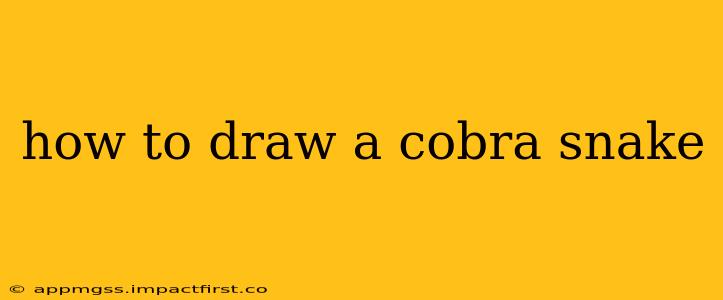How to Draw a Cobra Snake: A Step-by-Step Guide for Beginners and Beyond
Drawing a cobra, with its iconic hood and striking features, can be a rewarding experience. This guide will take you through the process, from basic shapes to adding intricate details, catering to both beginners and those seeking to refine their skills. We'll cover various aspects, ensuring you can create a realistic or stylized cobra, depending on your preference.
1. Starting with Basic Shapes: The Foundation of Your Cobra
Before diving into details, let's establish the fundamental forms. Think of the cobra's body as a series of elongated, slightly curved cylinders. The head is more complex, but we'll simplify it initially.
-
Step 1: The Body: Start by sketching a long, slightly curved line for the cobra's body. Don't worry about perfect curves; natural curves are more appealing. Thicken the line slightly to represent the snake's width.
-
Step 2: The Head: Add an oval shape at one end of the body for the head. This oval will be slightly wider at the back than the front.
-
Step 3: The Hood: Draw a slightly flattened, wider oval extending from the back of the head. This forms the base of the cobra's hood. The size of the hood relative to the head will vary depending on the pose and your artistic style.
2. Refining the Form: Adding Details and Proportions
Now we'll refine the basic shapes and add some defining features.
-
Step 4: Neck and Body Curves: Smooth out the transitions between the head, hood, and body. The neck will curve slightly upwards before merging into the body. The body should gradually taper towards the tail.
-
Step 5: Head Features: Within the head oval, sketch in the eyes (typically round and dark) and nostrils (small openings near the tip of the snout). Consider the positioning of these features carefully—they add to the snake's character.
-
Step 6: Hood Details: Inside the hood, sketch the characteristic markings. These are often patterns of spots, stripes, or other designs, and can be quite varied depending on the type of cobra. Remember, these markings will help define the hood's shape.
3. Adding the Finishing Touches: Scales, Texture, and Personality
This is where your drawing comes alive!
-
Step 7: Scales: Draw overlapping scales along the body and hood. Start with smaller scales around the head, gradually increasing in size as you move down the body. You can add individual scales or use a textured brush stroke to suggest scales.
-
Step 8: Tongue and Fangs (Optional): A forked tongue protruding from the mouth adds a nice touch of realism. If you want to show fangs, draw small, pointed teeth extending from the upper jaw. These should be subtle unless the cobra is in an aggressive pose.
-
Step 9: Shading and Highlights: Use shading to create dimension and depth. Add darker tones under the neck and body, and use highlights to showcase the shine of the scales. Experiment with different shading techniques to achieve the desired effect.
4. Frequently Asked Questions (FAQs)
What materials do I need to draw a cobra? You can use pencils (HB, 2B, 4B for varying shades), charcoal, or even digital drawing tools. A good eraser is essential for corrections.
How do I draw a cobra in a raised hood position? The hood will be significantly wider and more pronounced. The neck will curve more dramatically upwards. Ensure the head is positioned correctly to support the raised hood.
How do I draw different types of cobras? The markings on the hood are key differentiators between cobra species. Research specific cobra types to accurately depict their unique patterns.
How can I improve my cobra drawings? Study real cobra images (safely, from a distance!). Pay close attention to the details of their anatomy, scales, and markings. Practice regularly and experiment with different techniques.
By following these steps and using your creativity, you can successfully draw a cobra that captures its power and beauty. Remember, practice is key! Don't be afraid to experiment, make mistakes, and learn from them. Soon you'll be creating stunning cobra drawings.
